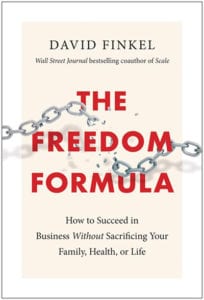David Finkel shows us how to bust through the myth that more hours worked equals more value created and shares how we can create maximum value without sacrificing our lives in the process.
Do you own your business or career… or does it own YOU?
In this “time and effort” economy, we often think that the more hours we work and effort we make, the more value we create in our businesses or professional lives. My guest this week, David Finkel is here to prove that myth wrong. A Wall Street Journal bestselling author, syndicated columnist for Inc.com, Forbes.com, and CEOWorld.com, the CEO of Maui Mastermind and author of the book, The Freedom Formula, David believes that building a successful business shouldn’t mean sacrificing ourselves, our families, or our health. He teaches business owners and professionals how we can refocus our energy and structure our days and priorities in order to create the maximum value for our companies, so we can truly reclaim the freedom to live the lives we desire.
Listen to the podcast here:
Download the audio file here.
How to Succeed in Business Without Sacrificing Your Family, Health, or Life—with David Finkel
This episode’s guest is David Finkel. David the author of The Freedom Formula, and co-author of Scale: Seven Proven Principles to Grow Your Business and Get Your Life Back, written with Priceline.com Cofounder, Jeff Hoffman. He is also the bestselling author of twelve business books. David and I discussed how to create more value in your business without sacrificing your family, health, or life. Pay attention to how David explains the exact process of how to arrive at a business sweet spot. Analyzing what is the focus that you need to do in order to scale your business. Also, read about the way David breaks down the steps and the questions he asks in order to train his team to proper delegation. Finally, pay close attention to the two practical tips David provides in order to balance your business and your life for growth and scalability. Without further ado, here is my interview.
—
David, thank you so much for joining me on the show.
I appreciate that, Meny. I’m so glad to be here with you all.
First of all, when I get an introduction from somebody that was on the show with people that appreciated that episode, I always say yes, regardless if I know that person or not. You came recommended by Gino Wickman. People on the show have read a couple of episodes speaking about the EOS platform and what Gino spoke about entrepreneurship in general. I’m very happy and I want to thank Gino for making the introduction.
I appreciate it. We shared it without realizing it, the same publisher, and that’s how we originally met each other. The publisher said, “The two of you need to meet.” That’s how we originally struck up a conversation together quite some time ago.
The topic that you speak about, which is eye-catching to me and our readers, because we’re business owners. We’re hustling and trying to do what’s right for our business and for our family. That balance is something that’s very hard. The topic that you speak a lot about is how to create more value in your business without sacrificing your family, health, or life. This is something that you don’t always see in public when speakers go on stage and speak. Most people speak about the hustle, the grind, focus, leadership, so on and so forth. This is not typical but I know for our readers, this is a very important topic. I am very excited for our interview, but before we get started, a little bit about your journey and how you got to understand this topic to actually speak about this and make a difference in the world.
My background was once upon a time, many years ago, playing sports. I was trying to play in the Olympics, I got hurt. I took that drive and I went into business. I started my first company at age 26 with a business partner. We built that company and scaled it at about 100% per year for eight years. I sold it in 2005. The big thing was when I look back to how I did the business back then, I was single and I had no kids. To throw my entire life into the business was both fun and also, quite frankly, it filled a hole that that sports left. In the first round, I did it through hard work and through putting in the hours. I was working on another book called Scale. My co-author for that is Jeff Hoffman. He was one of the people who helped Scale and was one of the founding team members of Priceline.com. He was sharing about how they took Priceline.com from zero in sales to over a billion in sales and they did it in 48 months.
[bctt tweet=”The best leaders do manage flexibly. ” via=”no”]
We started comparing notes and I realized looking back, that how I built the business the first time, it wasn’t the hours and effort that created the value. In many cases, the hours and efforts I put in were counterproductive. It was smaller moments where I focused on things that mattered more and created the most value. When I got my team to do the same thing and get rid of the junk, that made such a difference. That’s been part of my passion. Everything changed for me when I had kids. I have three kids, Adam, Matthew, and Joshua.
When Adam and Matthew were born in 2009, it was no longer an option for me to be on the road traveling a week or two each month, giving keynotes or other things. I said, “That will not be the case.” I held them in my arms and it was this emotional moment. I realized that I needed to treat my business like an astronaut. I have a certain inventory of working hours, just like an astronaut has a certain inventory of oxygen and fuel. If that’s my limiting constraint, how do I optimize around that constraint? The Freedom Formula is my previous years’ journey as I scaled other companies using the same idea where, “If it’s not about hours and effort, but it’s about the value created, how can I create more value in less time for my company and have my staff do the same?”
I love the name, which is Freedom Formula and I think that there is a misconception out there for business owners. “How can I build my business on autopilot so I could sit at the beach, make money, wake up in the morning and I see the money come into my bank?” A certain percentage of people and business owners get to that level. Even for an average business owner, sometimes freedom could mean that they could focus on what they want to focus on even parts within their business. Freedom could also mean something that I want to be able to look at the bigger picture and focus on what’s coming next as products and stuff versus being in the business and grinding and grinding. I want to know a little bit about how you look at freedom when business owners look at the word freedom and what meanings do they put to it?
We work with my company, Maui Mastermind coaches hundreds of business owners in North America. One of the things that’s interesting, I’ve seen it for myself, and I’ve seen it for clients who’ve scaled successful companies, very few of us have the fantasy of retiring and laying on a beach. That just doesn’t do it. I sold the company in 2005. I would not want to lay on a beach for more than a few weeks at a time. It’s not what we’re motivated by. The Freedom Formula talks about, how do you build a company faster where it’s not about time and effort, but it’s about the value created?
Here’s an example. One of the people we work with, his name is Clayton. He has a home improvement business. he also does commercial ductwork cleaning for an apartment complex. It’s not a very glamorous business, but here’s what he’s been able to do. When he first started using these ideas, he was probably working 70, 80-hour weeks. He’s a young guy at the time, he was in his late 20s, early 30s. Fast forward, he takes 1 to 2 weeks off every quarter. He’s working 35, 40 hours, which fits for him. He doesn’t want to work less than that and for example, for me, I want to work 40 hours a week. That’s about the right level for me, between all the different businesses that I run.
I don’t want to work more than that. I want to take at least ten weeks off every year with my family of a true vacation. Everyone’s got their own definition of it. The idea behind The Freedom Formula is not about laying on a beach and having mailbox money coming in or through the credit cards on the website. It’s about, how do you build your business more intelligently? How do you operationalize yourself and your staff on what it means to work smarter, so it becomes the given inside of your company?

You mentioned Jeff Hoffman, who co-authored a book with you, the Founder of Priceline. That’s the success story, which is on the books, as we say. Getting to that amount of money and that amount of valuation in four years. Based on what you were speaking to business owners and your definition of success, how do you differentiate between business growth and business scalability?
The key is, too many business owners have as their single metric for business success, they look at profitability. Some will look more sophisticated about that, but I tell our clients that we want to look at growth as growth of top-line and bottom-line revenue, but we also want to look at the growth of what we call strategic depth. What it essentially says is, “How do I build a company that’s independent of any one person, whether that be the owner or key executives in there, or even key staff members?” What that is, is you build a business that relies not just on a team, but relies on a well-trained team that are cross-trained for each other. Good systems and processes in place with internal controls, and a culture that says, “At our company, the way we build a business, is to make sure that there’s always a backup for how we do it. We’re a process-driven company.”
It’s not glamorous, but it’s a simple process by which every quarter I can make the business a little bit more depth in there, which lets me scale faster. Going back to your question about growth and scalability. What I find is, if I build strategic depth is one of the goals along with profitability, strategic depth by definition is a base upon which I can scale faster. If I’ve got that redundancy, that process procedure, and the operations well-tuned, I can handle growth. I can handle 50%, 100%, 200% growth in a year. Whereas for most small businesses or mid-sized companies, if they were to double in size in a year, they’re bursting at the seams and things are falling through the cracks. They’re one employee quitting away from complete chaos. That’s what we want to fight against.
What would you say to a person reading this? Maybe they’re growing and they were excited for the growth at first, but obviously, with growth comes the growing pain and the management, which is the issue. What would be the necessary steps? Where should they start looking at? When should they start pausing and adopting in order to make sure that that growth is sustainable?
I’m going to answer it with three quick comments. Number one is the thing that stops most business as we talk about in the book, The Freedom Formula, the five chains that hold people in this time and effort economy. One of them, the one that’s most common for entrepreneurs, is what I call control-itis, the inflammation of your control gland. That drive that says, “I’m so uncomfortable not being in control that I want everything to come back through me.” That’s the biggest constraint for most companies. What I see, a business owner who scales her company, she goes from $5 million to $10 million in revenue. She now still has everything coming back through her. It’s twice the revenue, but it’s four times the pressure on her shoulders, and it’s just not sustainable.
Here are two simple practical things we can do. Number one, the next time a staff member comes to me with a problem that they should be able to handle, I’m going to give people a question to say back to them. This came from Stephanie Harkness, who was a former client, a mentor of mine, and a co-author of a different book I wrote called Build a Business, Not a Job!. She’s a life success person. She’s in her 70s, built multiple companies and sold for $100 million-plus. She is the former Chairperson of National Association Manufacturers and a 50 plus year marriage. She’s a true, good person.
She challenged me many years ago. She said, “David, I want you to write the following question down on an index card, and the next time someone comes up to you asking what they should do, read the index card.” Here’s what she made me write. “I don’t know. What do you think should we do here?” As my staff came to me, I started asking that question. Later, I added a second side, which said, “If I wasn’t here, what would you do?” What I discovered was 7, 8, 9 times out of 10, their answer was pretty good. I said, “Go ahead and get that done.” If they gave me a bad answer, an answer I knew to be wrong, I would coach them through it. I say, “Tell me why you said that. If you couldn’t do that, what else would you do? How might that be better? Have you considered this?”
[bctt tweet=”If the stakes are low and someone makes a mistake, then what a great learning opportunity for them.” via=”no”]
Yes, it took a little bit more time, but if I look back, going back to why I would want to solve for them, I like the feeling of being the one with the answers. My own drive for control and feeling important was hurting my business. Quickly, the third comment, I would say, I want to give practical insight here for somebody, this is not an all or nothing proposition. This is a process that unfolds. If I can, each quarter, make my business a little bit less reliant on me, and a little bit more depth to it and then do that again and again. It starts slow, but over the course of 24 to 36 months, I’ve seen it with lots of client businesses, where the owner or the key executive has been able to revolutionize the business making it scalable. At the same time have some sanity with the work hours that they put in.
This is good. I’m going to start using it. I always say when we teach leaders when we have the Leaders Forum when we speak about delegation, there’s always one leader that will pop up and say, “What if they make a mistake?” I always answer, “We also make mistakes, and the beauty of that is, while they’re making a mistake, at least we’re focusing on the next big thing.”
Going back to they’re going to make a mistake, there’s a technique we talked about in the second half of The Freedom Formula book. It’s called the Capability Spectrum. If I were to share that with your readers here before I hand it off, I have to ask myself, “On a scale of 1 to 10, how qualified, capable, and experienced are you in this specific responsibility right now?” If you say 2 or 3, I manage a 2 or 3 on the 1 to 10 very differently on that capability spectrum than if I answered an 8 or 9. If I answered an 8 or 9, if the stakes are medium or lower, and he’s that capable, I have to stay out of it. I hand it to him and I let him run with it. I might have a follow up or way of closing the loop.
If I do that with someone who’s a 2 or a 3, that’s ridiculous. A 2 or a 3 thinks that’s abdication. Whereas a 2 or a 3 needs me to do with them, have them watch me do it, or have me match them with someone else to learn the process. Whereas someone who’s an 8 or 9, they would say, “David, quit micromanaging me. Let me do what I know how to do.” By pausing and asking, “Where is this person on a scale of 1 to 10 for this before I hand it to them?” It changes how I manage and that’s what the best leaders do. They manage flexibly.
Always when I speak to leaders about delegation, and this is a topic that every leader needs to learn, “Nobody gets born with being a proper delegator.” They always say, “My horror story is I passed on this project and it went sour,” or “I passed on this client relationship.” They always have those stories. Most of the time, it’s because there wasn’t a proper handover. This means a proper training process to understand if this person is ready for that type of project. You need to be able to build that trust and understanding that that employee will not get to number ten. They’re not going to be the perfect person thinking or doing like you in the first shot. That process needs to be learned.
The lesson most of us learn unfortunately is, “If I hand it off, they’re going to screw it up. If you want something done right, I’ve got to do it myself.” That goes back to that control-itis. If the stakes are low, and someone makes a mistake, what a great learning opportunity for them, but I have to think about where they are and what they need for me in terms of management style. Rather than either dumping and running or micromanaging, I’ve got to have my situational style fit what they’re dealing with.

Throughout these years, you worked with hundreds and thousands of business owners between the masterminds, speaking, and collaborating. What would you say, for a person reading this, is the common theme that you’re seeing from those companies that are really not moving, as we call them? They’re still, flat, and not moving. Where are those bottlenecks happening? Is it in personnel? Is it the vision? Is it in structure? Let’s speak a bit about that.
I’ll tell you what I observe and this comes from working with thousands of business coaching clients, and then I’m going to give you my favorite technique to solve it. Most of them have staff that are focused on so many different things, that they’re dissipating or frittering away their very limited resources of talent and attention on too many different things that are not producing optimally. How do I solve that? I want to get my best attention focused on my highest value things. That’s great to say, but what does it mean to do that?
Here’s a technique that comes straight from The Freedom Formula book. We call it your Sweet Spot Analysis. I pick what’s the single biggest limiting factor in our company. The one constraint more than anything else that currently restrains growth. Maybe it’s not having enough lead generation or maybe you say, “David, we have enough leads, but our conversion is horrible,” or, “We have enough leads and conversion, it’s capacity that’s our challenge.” Whatever it is, we put our finger on the single biggest constraint to growth. That Limiting Factor, then I put it through the Sweet Spot Analysis.
I do three things. Number one, I brainstorm ten plus ideas to push back that Limiting Factor. I need a minimum of 10, ideally 15 or more. For example, if lead conversion was my issue. Ideas would be, hire more salespeople. Figure out an automated process to sell online. Do better with my lead management. Find ways to sell to a group. Find ways to shorten the sales cycle. I come up with these ideas and then I put each of these ideas through two filters. Low hanging fruit filter and the home run filter.
I go through every idea and ask, “Is this a low hanging fruit?” It’s defined as, “Is it easy to do with a high likelihood of working?” I put a little checkmark with it in a box, it says LH by any of those ideas that are a low hanging fruit. In a second separate pass, what I do is I go back and ask, “Is it a home run? If it works, will it produce a big result?” I check the HR for the home run box for that. Anything that is both a low hanging fruit and a home run by definition is my sweet spot.
It’s an incredibly high leverage place that has something it’s easy to do, with a high likelihood of working, and will make a big impact on pushing back my number one constraint to growth. Every quarter, I step back. We do this with our coaching clients every quarter. Part of when you look at scaling a company as the process of quarter by quarter identifying your number one constraint to growth and pushing that constraint back. Usually, when I push a constraint back, within 1 or 2 quarters, it now reveals a different constraint to growth, and so I solve that. By doing this, this is how I hack growth faster.
[bctt tweet=”Do less, but the less has to matter more.” via=”no”]
Is this something a leader should do with their teams?
It depends on the company. If I’m a company, and I’m in that owner’s reliance stage, where I’ve got maybe four people who work for me, and they’re mostly doers. I might decide that myself the 1st or 2nd round, but eventually if I have a team with people that I want to grow, develop, and have be engaged. I’ll get them to be part of this brainstorming with me. Initially, I might be more actively leading it, but later on, they can use this technique in their own areas of the company.
For example, if you have Teresa who runs your operations. She’s trying to figure out a better way to make the process by which you do your marketing or branding services for a client more efficient, she can do a brainstorm on that and do her own sweet spot analysis to improve it. Different people can use that same idea. It’s very flexible. Eventually, you want this to be something that all the key people can have participation in. You don’t want to have this held by one person. That control-itis situation. However, I have to be realistic that you might not have staff who have the maturity yet to know how to do this currently. Maybe you start off the first time yourself.
For our readers, I want you to pay attention. If you didn’t pay attention exactly to the practical advice that was shared. I encourage you to go back and write down what we discussed because, based on conversations I have with business owners, this is where people are confused. We always get confused between the sweet spot, the shiny object, or the next big thing, where’s my competition focusing on, so on and so forth. We get so confused about where our energy should be focused on. Most people forget what’s working, or what’s the low hanging fruit, what will make a big impact in your business, and just focus. Zoom in with your team on that and that will make the whole difference.
Following up with that, one of the things we do with coaching clients is we create a one-page plan of action every quarter that has at most three focus areas with defined criteria of success. By keeping it to one page, it’s critical. I’ve seen people have 5 or 10-page plans of action and they ignore it. It’s too overwhelming, but one page I can keep in front of me. As a side note, anyone who wants to download our sweet spot analysis or wants to download the PDF for what our action plan looks like, they can do that at FreedomToolkit.com. They have all those as a PDF for free, they can get ahold of it right there.
That’s generous. Let me ask you a little bit about the book you wrote with Cofounder, Jeff Hoffman, from Priceline, Scale: Seven Proven Principles to Grow Your Business and Get Your Life Back. I want to leave our audience with a couple of pointers. Work-life balance is a topic that’s discussed sometimes in a way that’s not even practical and not possible, particularly the word balance. Here, you need to hustle. You’re starting a new business or you’re starting a new venture. Maybe you have your first child and you have to be with your family. It’s not a balance. It’s different times in your life where you need to focus. What I heard from you before is the 40-hour workweek that works for you. You balance it with the ten-week vacation. Talk to me about some practical tips or principles shared in the book that the audience would appreciate.

One is this idea of coming up with, what is your ideal work constraint? Is it that you have 50 hours of working hours? What’s the resource we have to work with? With that, we’re going to make consistently our hard stop. There will be times that you might have a week or two that things get out of whack. Let’s face it, every new parent for 6 to 12 months is going to be completely overwhelmed by parenting and I certainly felt that way, all the time throughout that. That said, number two on the business aside, if I can focus my team on the things that matter more, here’s the key phrase, “I want to do less, but the less I do has to matter more.”
Much of our time is further away. We have something we talked about in Scale and also in The Freedom Formula called the Time Value Matrix. It’s a simple way of taking Pareto’s principle and putting it on steroids. Most people are aware of this idea that there’s this 80/20 rule. Eighty percent of what I do creates very little value that 20%. We call that D time. That 80% mass that creates very little value. On the flip side, 20% of what I do, which we call C time, generates a leveraged return. It generates 80% of my result, and that’s pretty cool. Four times less gives me four times more. Every one hour of C time is worth sixteen times an hour of D activity. If we take that same idea and apply it again, then 20% of the 20% gives me 80% of the 80%. We call this 4% sweet spot B time. It’s the 4% that generates 64% of the result. If we do it one more math time, 20% of the 20% of the 20% gives me 80% of the 80% of 80%.
That works out to be as magic 1% gives me half the result. I don’t think Pareto’s principle is a literal thing, but I do think that there are things that I do in my business that are magnitudes more valuable, A or B activities versus the C and D stuff. What I have to do is make sure that I create blocks of uninterrupted time regularly in my week, so that I can do A and B level activities. I start off by first identifying what it is I do that are my A and B activities. For example, maybe for you doing this show might be a B level activity. It might be initiating a joint venture relationship with the right person. It might be doing a high leverage high profile speaking event. These are all examples of what might be an A or B activity for you and your company.
What it probably isn’t, is doing junk email. What it probably isn’t is working one to one with a client. Maybe years ago, one to one with a client would have been A or B time for you, but now it’s probably C time. It matters, it’s valuable and billable, but it’s not your highest value. When we look at that way, what I do is I say, “How do I make sure that every week I get some time for A and B level work?” I don’t need a lot. We tell our clients, if they can free up one day a week that they have a three-hour block of focus time to focus on A and B activities this focus day, and then on their other days, which we call push days.
Even if they took just an hour on those other days, I might only change 5 or 6 hours in a week of how I did my time, but because I make it a recurring appointment on my calendar to have this focus block. Because I set the stage the day before I come in to do that focus time, in those 5 or 6 hours, each week, I might very well create more value for the week than everything else combined. Five hours a week, times 38 weeks per year, that’s five weeks of working on your very highest value activities. Most businesses, the leaders there, they don’t even get an hour of uninterrupted time for their highest-value activities. This is a simple methodology we talk about in Scale and The Freedom Formula of how to go about creating the time and space to focus on your highest-value activities.
I find it mind-boggling when I speak to leaders. Some of them have successful companies with maybe even hundreds of employees, and they don’t even have any time management in place. They wake up, start their day, and they let it roll. They manage their time instead of managing the day. Sometimes I speak to business owners, we start speaking about the concept of time management, putting things in your calendar, and blocking out time for those priorities that we discussed. They say, “How much time are you putting into scheduling?”
The answer to that is if you don’t take the time to schedule those hours and blocking out those times, it doesn’t happen. When you’re a leader, you have to focus on stuff that if you don’t do it, nobody else will do it. In managing your clients, you have account management, account executives within your company, or customer service reps, whatever you do. If they’re there to do that, then even if you don’t do it, somebody else will take care of it, but those high-level work, nobody else is stepping up and saying, “I’m seeing the leader is not doing it. I’m going to set away a couple of hours and do it for you.” It’s not happening.
It’s so easy to do. For example, I was doing a keynote for a construction industry group and in the room was one of my clients. His name is Jesse and he runs a construction company with his brother Howie. He was telling me afterward, “Dave, thanks for coming to this event, but I want to let you know I’m feeling a little bit anxious. I’m feeling a little bit out of control in my business.” I said, “Tell me more.” He did. He explained the situation and I laughed. I said, “Jesse, show me your phone.” He looked at me like I was crazy. “Show me your phone?” I said, “Hand me your phone right now. Unlock it. Open up your Outlook or whatever you use for scheduling and show me your phone.”
On his phone, I said, “I don’t see any reoccurring appointments for yourself for focus time.” He goes, “I got it.” I saw him again three months later. The first thing when I saw him, he handed me his phone and there it was in his phone his blocks of time. It doesn’t take a lot. All I have to do is put it in there as a recurring appointment. I don’t have to do it every time, but if I’m 80% of the time or better following that, it takes me 5 to 10 minutes to plan my week because I’ve got those islands of time already identified. The result from that can be that I get 4 to 5 hours or more. I do focus days’ time on Tuesdays, Thursdays, and Fridays. I get probably anywhere from 12 to 15 hours of great focus time per week. Since I’ve been doing that, A, the business is more enjoyable. B, it runs better, and C, we’ve been having great growth. It’s not that hard to do. You start small. A focus day a week for a 2 to 3-hour block would be a place to start. Everyone can do that as a recurring appointment in their calendar.
I always tell those leaders to start small. This means if you are a person that’s still involved in the day to day grind, and you can’t do it. Twice a week just arrive at the office 30 minutes later and take those two 30 minutes, there you have one hour to go. Once you start seeing those wins, we call them the small wins, on the effort that you put in, and then the execution of that blocked out time, you’re going to start doing more and more of those times. I encourage our readers to take action and work on time management and delegation. That’s going to be key to anything else we discussed on this episode. Let’s close with the four rapid-fire questions. Number one, what’s the book that changed your life?
How to Stop Worrying and Start Living by Dale Carnegie.
Number two, what’s a piece of advice you got that you’ll never forget?

Ask three questions when you’re making a decision, “What matters most? For the sake of what? How much is enough?”
Number three, anything you wish you could go back and do differently?
Yes, not worry so much.
Last and final question what’s still on your bucket list to achieve?
To show my kids what it looks like to have a lifelong, committed, loving relationship of two faithful partners forever. That’s probably the most important goal in my life.
David, thank you so much for joining us. I know your time is valuable. That is why in the name of our readers, we will forever be grateful for sharing some of your time with us.
Thank you.
It’s my pleasure.
Links Mentioned:
- David Finkel
- The Freedom Formula
- Scale: Seven Proven Principles to Grow Your Business and Get Your Life Back
- Priceline.com
- Gino Wickman – Previous episode
- Stephanie Harkness
- Build a Business, Not a Job!
- Leaders Forum
- FreedomToolkit.com
- How to Stop Worrying and Start Living
- www.MauiMastermind.com
- Maui Mastermind – Facebook
- @DavidFinkel – Twitter
About David Finkel









